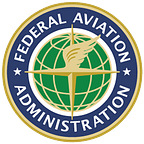Peter Sachs
UTM Implementation Program Manager, FAA Unmanned Aircraft Systems Integration Office
By Paul Cianciolo, FAA Safety Briefing Associate Editor
Remember those little plastic headphones that connected to the armrest of an airliner? Peter Sachs does, because United Airlines’ Channel 9 sucked him into aviation while he tagged along on his dad’s business trips.
“What a thrill!” he explained. “I learned to spot other aircraft out the window based on traffic calls, laugh at the jokes and ride reports, and keep track of our landing and takeoff sequence. At San Francisco International Airport (KSFO) — our home airport — I was in awe listening to controllers and pilots manage the mind bogglingly complex dance of big, loud jets. I tried to imagine myself doing it. A long and winding path eventually got me there.”
Before becoming an air traffic controller in 2010, Peter earned private pilot and flight instructor certificates in college. An airline career wasn’t of interest, so he opted for a “steady” career in print journalism. He reported from places like Cairo, Chicago, and Washington, D.C., but then the Great Recession hit.
“My first air traffic facility was Chicago Executive Tower (KPWK) — an ideal place for someone like me who thought himself a hotshot — to get put in his place trying to sequence business jets and Skyhawks or run simultaneous patterns on intersecting runways,” he said. “I eventually got good at it, but not without a lot of go-arounds first.”
Two years later, he got a call for duty at SFO, full circle to where his aviation journey began.
In 2013, Peter and his colleagues watched as Asiana Airlines Flight 214 cartwheeled down the runway and crashed. This tragic event motivated Peter to learn more about aviation safety. He got involved with the Standard Terminal Automation Replacement System (STARS) radar transition and electronic flight strips for controllers. In 2017 he was detailed to work quality assurance, identifying and fixing systemic safety problems at SFO.
But with a new son and no alternative to front-line shiftwork, Peter joined Airbus to work on Unmanned Aircraft System (UAS) Traffic Management (UTM). He leveraged his controller experience into UTM service architecture, applying safety culture concepts and contributing to development of UTM standards.
In 2020, Peter returned to the FAA to work on the strategic implementation of UTM. He works with a team that focuses on how to safely enable widespread and scalable deployment of complex UAS operations. A key challenge is determining effective ways to mitigate collision risk between UAS and traditional aircraft.
“The policies we put forward now, even for localized UAS operations, set a precedent, and we know that we need to ensure the safety of the NAS above all else,” he explains. “Working through how to do that with technology, big data analytics, and applying the same layered mitigation strategies used for every VFR and IFR flight today is the challenge we greet every day.”
Peter is also actively working to put “aviation safety culture” front and center for the drone community. He urges traditional pilots to take a drone pilot friend or colleague out flying to show them what it’s like from a traditional cockpit — and then watch them fly their drone.
“This kind of cross-pollination and education within pilot communities can be a lot more effective at improving everyone’s safety mindset than an FAA enforcement campaign.”
Paul Cianciolo is an associate editor and the social media lead for FAA Safety Briefing. He is a U.S. Air Force veteran, and an auxiliary airman with Civil Air Patrol.